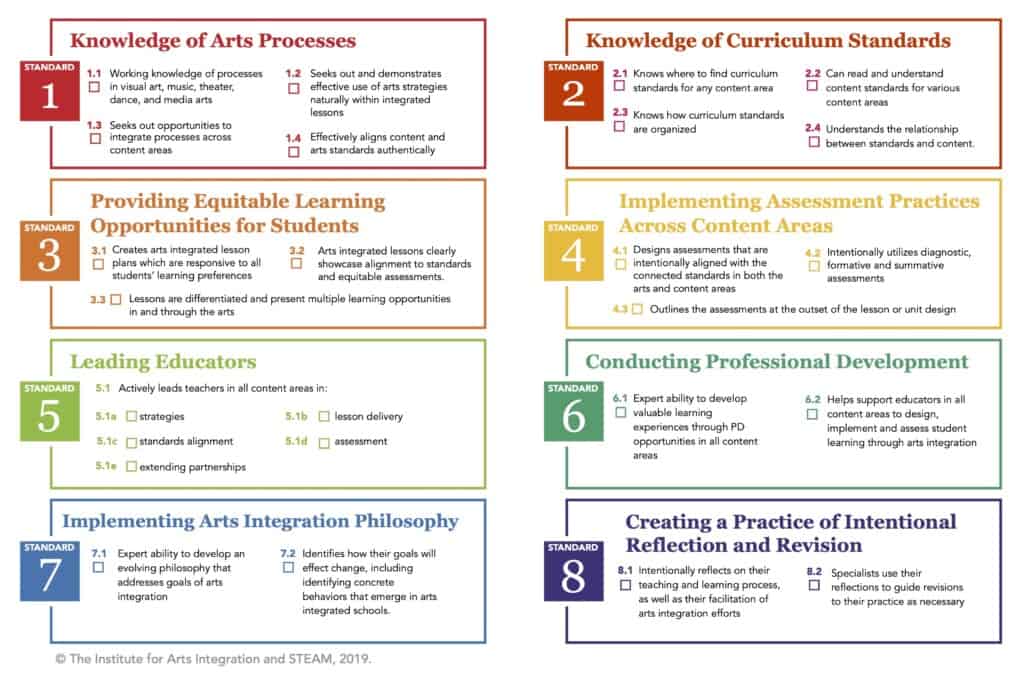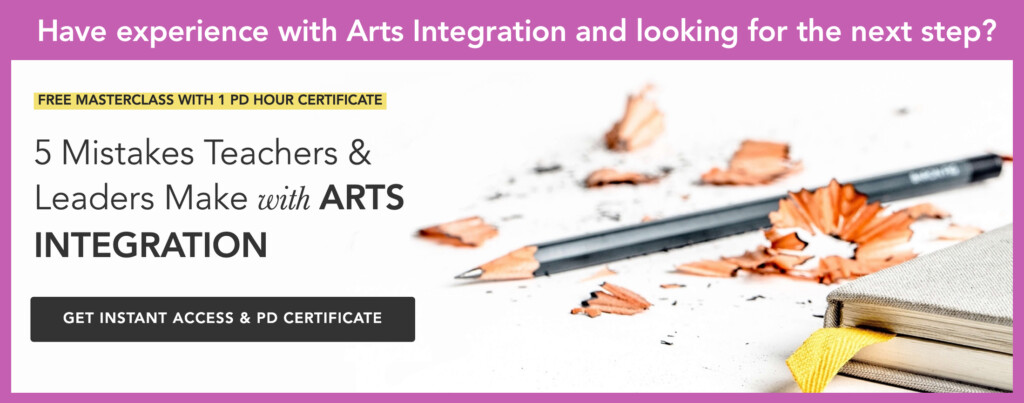8 Standards for Arts Integration Specialists
TRANSCRIPT
When schools are investing in and beginning the process of arts integration, they are sometimes hiring arts integration specialists to support them. They may also use teacher leaders in their own buildings to lead this effort organically. That said, how do we know what success looks like for these educators? We’ve developed a set of specific standards for arts integration specialists to ensure that what they’re doing in schools is actually going to work and be meaningful.
When I say “work”, I mean that we’re actually going to see results with arts integration. One of the things that’s disappointing about arts integration is that sometimes schools stop using it – usually within one to three years. Why? Because they’re not seeing the results that they expected.
The research tells us that when we’re using arts integration, schools can expect improvement of student test scores, and they can see improvement in teacher efficacy and joy. We see students who are more engaged and hands-on in their learning when they are taught through arts integration lessons. We’re seeing less classroom disruptions and more attendance to school when arts integration is used strategically. All positive things, right? The key here is that arts integration is used with integrity, that we’re putting it into place in a way that is both meaningful and that is aligned to standards and that is connected to what we’re already doing in schools.
8 Standards for Arts Integration Specialists
So how do you ensure that is happening? Well, through a set of standards. So I wanted to share these standards with you today. This way, you know exactly what to look for – whether you’re hiring an Arts Integration Specialist or if you are stepping into that role – so that you can understand what success can look like for your school or classroom.
Let’s take a look. These are the set of eight standards that Arts Integration Specialists who go through our certification program master by the time that they’re done. Additionally, just so that everybody is clear, each standard also has outcomes underneath of it.
Arts Integration Standards Development
How did we develop these eight standards for arts integration specialists? These are actually designed in conjunction with looking at the standards for the National Board for Professional Teaching Standards. So when we’re looking at what makes a best quality educator overall, how does that apply to arts integration? We set out to answer that question in the development of these 8 Standards.
DOWNLOAD A PDF VERSION HERE
The first standard is all about knowledge of arts processes. And so each of these indicators are things that we ask our arts integrations certification candidates to be able to do by the time they’re done. And so this is something that they’re constantly working on. They’re trained in and they can then bring to your schools things like knowing the processes of visual art, music, dance, and theater and media arts.
Looking for opportunities to integrate those processes across the content areas, looking for art strategies that could be naturally woven into integrated lessons, and effectively aligning content and art standards authentically. Anybody who has looked at standards and standards alignment know that that’s a difficult piece. And so that’s why we spend almost all of Sprint 1 in our certification program going over how to do that. So that when you walk away from that Sprint, you are empowered to be able to align those standards and know what’s a good fit.
They also know those curriculum standards. That’s standard number two. So specialists know where to find curriculum standards for any content area. They know how the curriculum standards are organized. They can read and understand content standards and then understand the relationship between standards and content. So they become this really valuable resource in your school because they can be the reference point for looking at standards, unpacking them, understanding them, and then connecting them.
In standard three, we’re looking at providing equitable learning opportunities for students. So this looks like creating arts-integrated lesson plans that are responsive to all students’ needs. Looking at arts-integrated lessons, that clearly showcase alignment to the standards and equitable assessments, and that lessons are differentiated and present multiple learning opportunities and through the arts.
In Sprint 2 of the certification program, we actually guide our enrollees through this process of how do you design a really equitable, outstanding arts integrated lesson and assessments, which is part of standard four. So this is implementing assessment practices. Specialists can design assessments that are intentionally designed and aligned with connected standards. They utilize diagnostic, formative, and summative assessment measures, and they know how to outline the assessments at the outset of a lesson or a unit. So again, the folks who go through the Arts Integration Certification program understand how assessment plays an active role in a lesson and what kind of assessment that should be used. They know how to prescribe the correct assessment that’s going to get the best understanding of student learning.
Standard five is all about leading educators. This is actually provided as training in sprint three of the certification program. This is when you understand how to actively lead teachers in all content areas through strategies, standards alignments, extending partnerships, lesson delivery, and assessments. You can teach them using adult learning theory. And you can conduct professional development that is a valuable learning experience through PD opportunities in all content areas. These folks also know how to help support educators in content areas to design, implement, and assess student learning through arts integration. They use that adult learning theory to support educators in evolving year-long professional development.
Finally, our last two standards, these are actually covered in the final sprint of our certification program. These are called implementing an arts integration philosophy and creating a practice of intentional reflection and revision. These standards are all about how to understand the arts integration philosophy overall, how to develop something that is evolves over time and addresses the goals of arts integration.
These specialists also participate in that practice of reflection, including reflecting on their own teaching and learning process, as well as facilitating arts integration efforts of others. They use their reflections to guide revisions to the practice as necessary.
High-Quality Arts Integration Specialists
Each of these standards are what high quality arts integration specialists do. It embodies what an arts integration specialist does and who they are. One of the things I’m most proud of about our Arts Integration Certification Program is that when our candidates graduate, they have all eight of these standards kind of just emanating out of them. They know how to do this, and they’re trained in each of these areas specifically to be able to support schools in seeing that effective change that we’re looking for with arts integration.
Ready for more? Check out our free on-demand masterclass: 5 Mistakes Teacher and Leaders Make with Arts Integration. You’ll receive a 1 hour PD certificate just for watching, plus helpful ideas for avoiding common arts integration pitfalls.




